2005 VOLKSWAGEN GOLF brake
[x] Cancel search: brakePage 315 of 444

Booklet 3.2 Tips and Advice
be taken working on
(Automatic tran smissio n).
2. Apply th e parkin g brake firmly.
3. off the eng in e and remove the
k
ey f rom the ignition.
4. Wail
for the engine to cool down.
5. Keep chi ldren and othe rs away from the
ve hicle .
6.
the e ngin e hood.
All serv ice fluids. sp ark plugs . batteri es etc. are
constantly being develo ped and improved. kept up-to-da te
by the manufactur er. For thi s reaso n mend that you have these replaced by an rized Volkswage n dealer. A lways read the notes
b elow . Th e e ngin e or any motor vehicle is a hazardous
WARNING
E ngine
fo rni a cause cancer and birth defec ts and reproduc tive harm. In additio n, certain fluid s
containe d in vehicl es and cerlain products of component wea r co ntain or emit ch e m ica ls
kn ow n to th e to ca use
ca ncer a nd birth defect s o r o th er r eproductive
h arm.
Ba ttery pos ts,
th e of to
(continued)
cause ca ncer and reproductive harm. hands after handling.
WARNING
T he e ng in e comparlmenl of any m olo rvc hicl c
is a polcnli ally dangero us area ca n ca use seriou s pe rso nal inju ry.
Alwa ys use extreme ca ution when doin g
any work in he e ng in e compartment. Always
follow commonl y acce pled p rac tice s and usc common se nse. Neve r risk perso nal
injury.
Never perform any work in the e ng in e
compartment unless you know exactl y how to
ca rry ou t th e job
ni cal info rm ation and th e correcltools ! you arc uncerla in w hat to have the wo rk
p erformed by an aulhorized Volkswage n
d ealer or works hop. Se rious
form ed work.
Neve r o pe n the engine hood if you see stea m or coola nl escap in g fro m the en g in e comparrment. I-Iots team orcoolanl ca n cause serious burns. Alw ays wait until yo u no longe r sec or hear stea m or coolant escap ing fro m the engine.
Alwa ys le t th e en g in e cool do wn pl ete ly before care full y opening the engine
h ood. I-lo t compone nt s will burn sk in on tacl.
th e e ng in e has coo le d down and you
selecto r mati c transmi ssio n).
- Rem ove th e k
ey from the ign ition.
- K
eep children and others away from
Page 316 of 444

WARNING (continued)
Never reach into the area around or tou ch the radiator fan. Contact w ith the blade s can resuh in se riou s personal injury. Always m ember that the radiator fan is controll ed and can turn on
m oved from the ignit ion.
Never unscrew the coolant expa nsio n tank cap when th e engin e is hot. A hot engine will heat the coo la nt and put it under pressure . mov in g a cap that i s under pressure ca n rcsuh in seriou s personal injury and/or burns.
A lway s prote ct face, hand s and arms from hot esca ping coolant or steam b y cove ring the ca p with a large, thick rag.
Turn the cap slow ly a nd very carefully in a
counter- clo ckw ise direction whil e applying
light downward pressure on the top of the cap.
Never spill on hot engine parts o r hot
e xhau st sys te m . S pilled
Neve r short-circuitthc elec trica l sys te m ,
es peciall y w here th e jumper cabl es are tached -th e balleri es could explode!
Neve r leave any objects in the e ngine partment, for exam ple cleaning rag s and too ls. Objects
Neve r work unde r the veh ic le unless you
h ave safely secured th e ve hicl e from movin g.
I f yo u must work under th e ve hicl e wit h th e
w hee ls on th e ground, always make sure the vehicl e is on leve l ground, th e wh eels arc
b locked from movin g and th e key is not in the
ignition.
Always support your ve hicle with safety
s tands if you have to wo rk underneath it. The
ja ck suppli ed with the ve hicle is not s tron g enough for this purpose and can co llap se causin g se riou s personal injury.
If you have to perform a check or r ep a ir
w hen th e e ngine is running, there arc more
ri sks from
the ro tating parts, such as the drive
WARNING (con tinued)
Neve r to uch the e lec tr ica l w ir in g of the ig ni tio n sys tem.
Always make sure that j ewe lry, loose clothing and lo ng hair do not get caught in
rota ting engine pans. Before startin g any work remove jewelry, tie back and cover
hair, and do not wear clothing that can hang down and get caught in mov ing gin e parts.
Always use extre me cauti on if the erator pedal has to be depresse d to perform
a ch eck. The vehicle could move suddenly, eve n if the parking brake is applied.
If wor k on the fu el sys te m or th e electrica l
syste m is necessa ry:
Always discon nect th e balleries. Make
sure th e vehicle is unlo cked when
Neve r sm oke .
Neve r work nea r heaters, wa te r h eaters of other open names .
A lways have an approve d fire ext guis her nearby.
To avo id electrical shock and personal jury w hil e the eng ine is running or being
s tarted :
n ever touch ignition cables,
never to uch othe r component s of the
high vohage electronic ignition syste m,
never touch the gas discharged (Xeno n) headlights wiring.
Note
Whe n chang ing or topp ing orr service fluids. make absolutel y ce rtain that you fill the fluid s
into the corr ect reservoirs. Using incorrec t fluids will resuh in serious malf unct ions and engine
damage!
For the sake of environment
Service fluid leaks are harmful to the environ-
ment. Reg ularl y check the ground undernea th
your vehicle . you find spots of oil or other
fluids. have your vehic le checked by your rized dealer or a qualified
Page 324 of 444
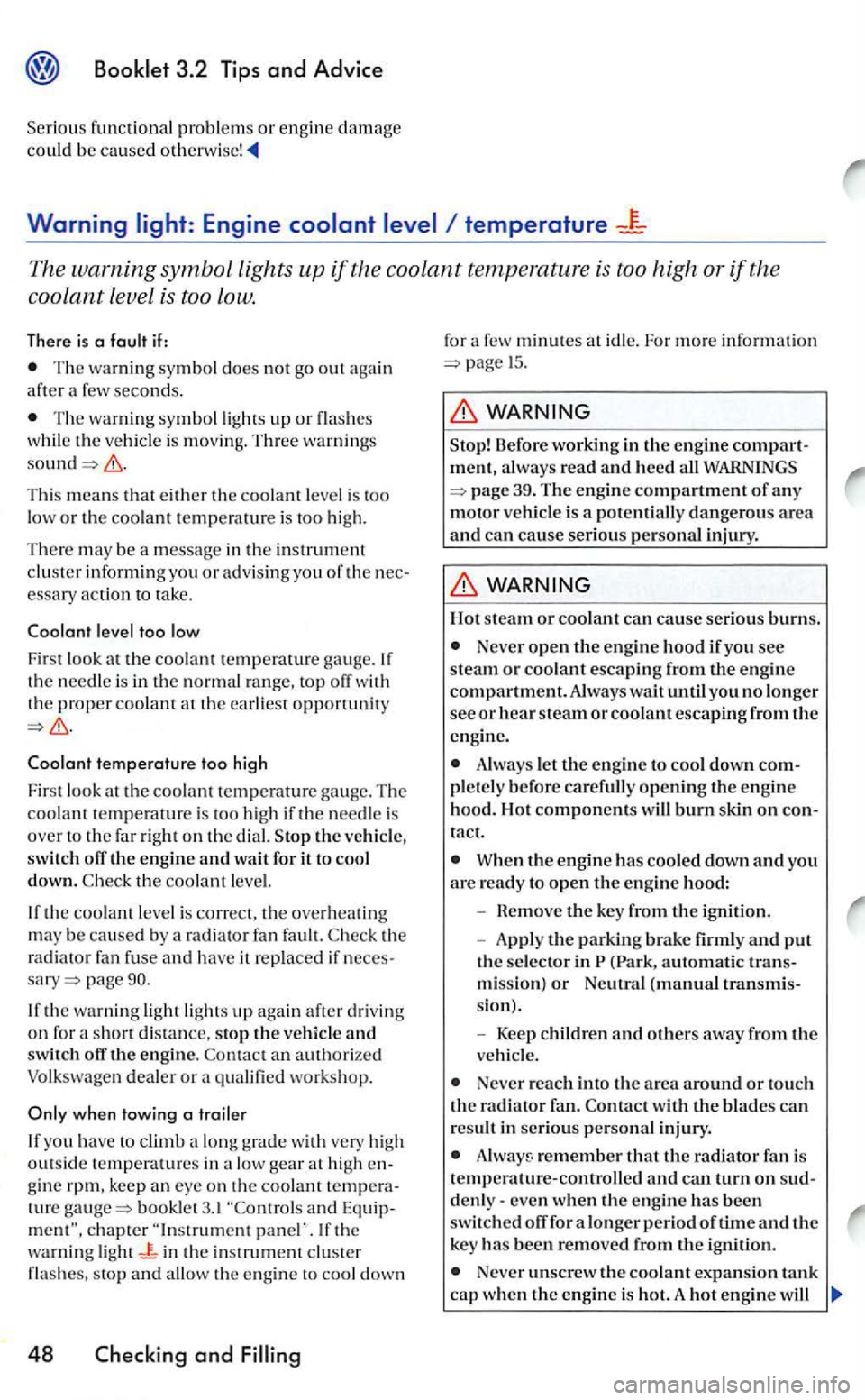
Booklet 3.2 Tips and Advice
functional problem s or engine damage could be caused
Warning temperature
The warning symbol lights up if the coolant temperatur e is too high or if the
coolant level is too
Low.
Ther e is a fault if:
The wa rnin g symbol does not go out aga in afte r a few seconds.
The wa rnin g symbol light s up or flas hes whil e the vehicle is moving. Three warning s
This means th at eith er th e coolant leve l is too low or the coo lant temperature is too high.
Th ere may be a m essage in the i
nstrument
clu ste r inf orming you or advi sing you of th e
Coolant temperature too high
Fir st look at the coolan t tempe rature gau ge. The coolant temperature is too hi gh if th e need le is
o ver to th e fa r right on the dial. the vehicle,
switc h the engine wait for it to cool down. the coo lant level.
I f th e coo lant level is co rrect, th e over heating may be caused by a radia tor fan fault. the ra diator fan fuse and have it replaced if page
If th e wa rnin g light lights up again after driving
o n for short distan ce, stop the vehicle switch otT th e e ngine. an authorized Volkswagen dea le r or a qu alified worksh op.
when towing a trailer
If you have to c limb a lo ng g rad e w ith high temperatures in low gea r at high gin e ture booklet 3. 1 and If th e
w arning light in th e in st rument cluster flas hes, stop and a llo w the e ngine to coo l down
48 Checking and Filling
for minutes at idl e. For more inform ation 15.
alw ays read and heed all
Hot steam or coolant ca n cause seriou s burns.
Neve r open the engine hood if you see steam or coolant escaping from the engine compartment. Always wait until you no longe r see or hear steam or coolant escaping from the
e n gine.
Always let the engine to cool down pl ete ly before carefully opening the engin e hood. Hot components will burn tact.
When the engine has coo led down and you are ready to open the engine hood:
-
move the key f rom the ignitio n.
- Appl y
the parking brake firmly and put the selector in ( Park, automatic mission) or Neutral (manual
Never reach into the area around or tou ch
th e rad iator fan. with the blades ca n
re sult in serio us personal injury.
remembe r th at the radiator fan is temperature-controlled and can turn on
fo r a longer p eriod of tim e and the
key has been r emoved fro m the ig nition.
Never unscrew the coola nt expansion tank cap when the e ngin e is hot. A hot engine will
Page 329 of 444
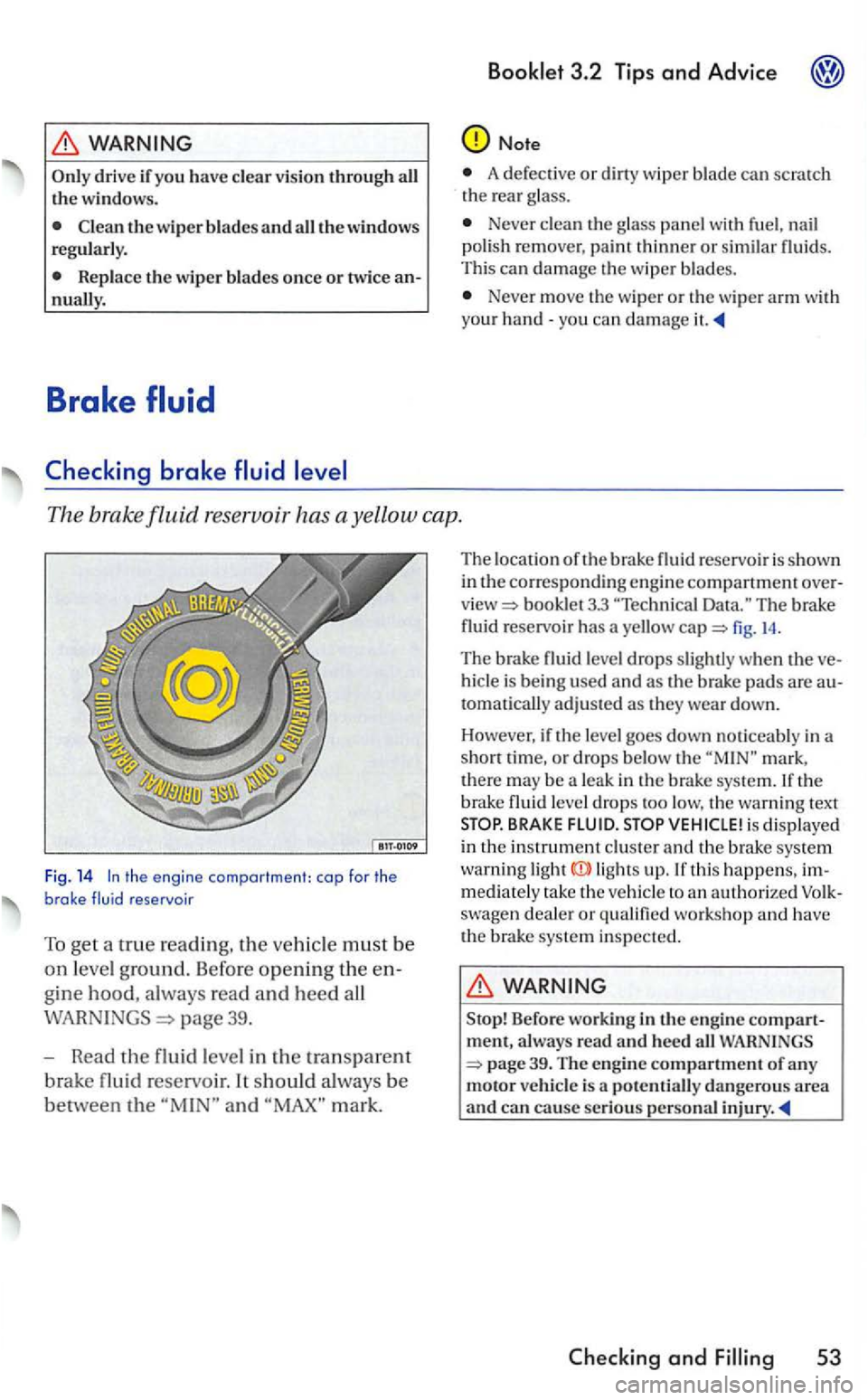
drive if you have clear vis io n through all the windows.
A defect ive or d irt y w iper blade can scratch
t h e rear glass.
Never clean gla ss panel with fuel. nail polish remove r, p aint thinn er o r similar flu ids.
Thi s ca n damage th e w iper bla d es.
Never move the w iper or the wiper arm your hand can dam age it.
The brak e fluid reservoir has a ye llow cap.
Fig. 14 the engine compartment: cap for the brake fluid reservoir
To get a true reading, the m ust b e
on leve l ground. Before opening th e en
g
ine hood, a lways read and heed all
page 39.
- Read
the fluid leve l in the tra nsparent
bra ke fluid re servoir. It should always be
between the and mark.
Th e lo cation of th e brake fluid reservoi r is shown
in
bookl et 3.3 The brake
fluid reservoir has a yello w fig. 14 .
The brake fluid lev el drops s lightl y when th e ve
hicl e is bein g used and a s th e brake pad s are autom atically adju sted a s they wear down.
Ho wev
er, if th e le ve l goes down noticeably in a
s ho rt time, or drops below th e mark ,
th ere may be a leak in the brake system. If the b rake fluid leve l d rops too low, the wa rnin g text BRAKE FLUID. is displayed
in the instrument clu ste r and th e b rake system warni ng ligh ts up. If t his happens, immediately rake th e ve hicle to an au thorize d swage n deale r or q ualifi ed wo rkshop a nd have
th e brake system inspected.
Stop! Before wo rkin g in th e engin e compartment, a lways read and heed all WARNINGS
53
Page 330 of 444
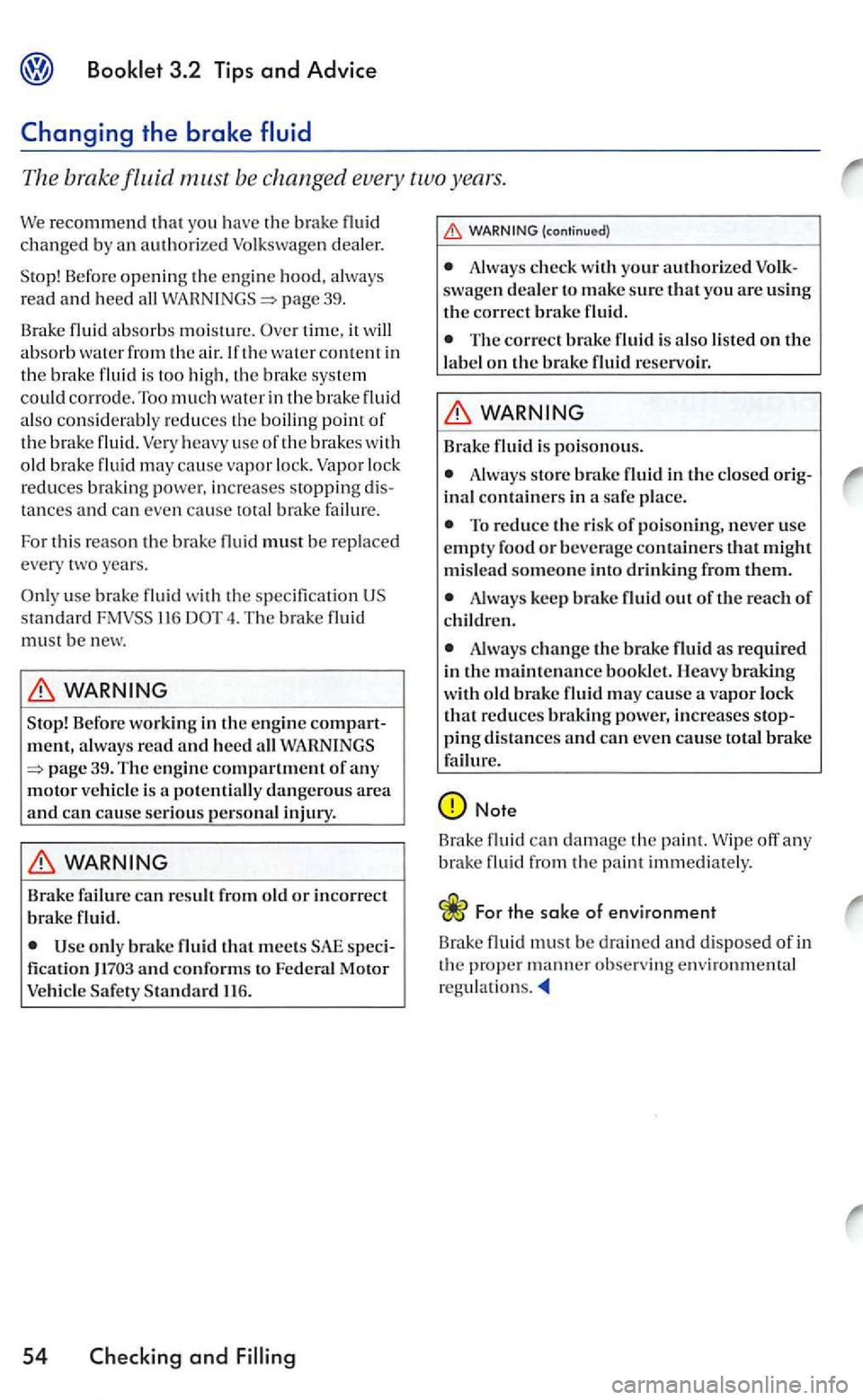
3.2 Tips and Advice
The brake fluid be changed every two years.
We recommend that you have the brak e changed b y an authorize d Volkswagen dealer.
S top! Be
fore openin g th e e ngin e hood, always
read and heed all page 39.
Brake fluid
absorbs m oisture. time, it will absorb wate r from the air. the wa ter content in the brak e fluid is too high, the brake sys te m
c
ould corrode. Too much wa te r in the brak e fluid
a lso consid erably reduces the boilin g point of the brake fluid. Very heavy use of th e brak es with
old brake fluid may cause vapor lock . Vapo r lock
reduces braking power, in cre ases stopping tances and can eve n cause total brake failu re.
For this r
eason the brake fluid must be repla ced
every two years.
use brak e fluid the s pecification U S standard 116 4. The brake fluid must be new.
Stop ! Befor e working in the engine compartment, always read and h eed all WARNINGS 39. The engine compartment of any motor vehicl e is a potentiall y dangerous area and can cause seriou s persona l injury .
Brake failure can result from old or incorrect brake fluid.
fica tio n
(continued)
A lwa ys check with your authorized swage n deale r to make sure that you arc u sing the correct brake fluid.
The correct brake fluid is also listed on the
labe l on the brak e fluid reservoir.
Always store brake fluid in the closed
To reduce th e risk of poisoning, neve r us e empty food or beverage containers that mi ght mislead someone into drinking from them.
A lwa ys keep bra ke flu id out of the reach of childr en.
Alway s change th e b rake fluid as required in the maintenance bookl et. Heavy braking w ith old brake fluid may cause a vapor lock that reduces braking power, increases ping distances and can even cause tota l brake failure.
Note
Brake fluid can damage the pai nt. Wip e off any
brake fluid from rh c paint immedia tely.
For the sake of environment
B rake fluid
must be drained and disposed of in
th e proper manner obse rv ing env ironmental
Page 333 of 444
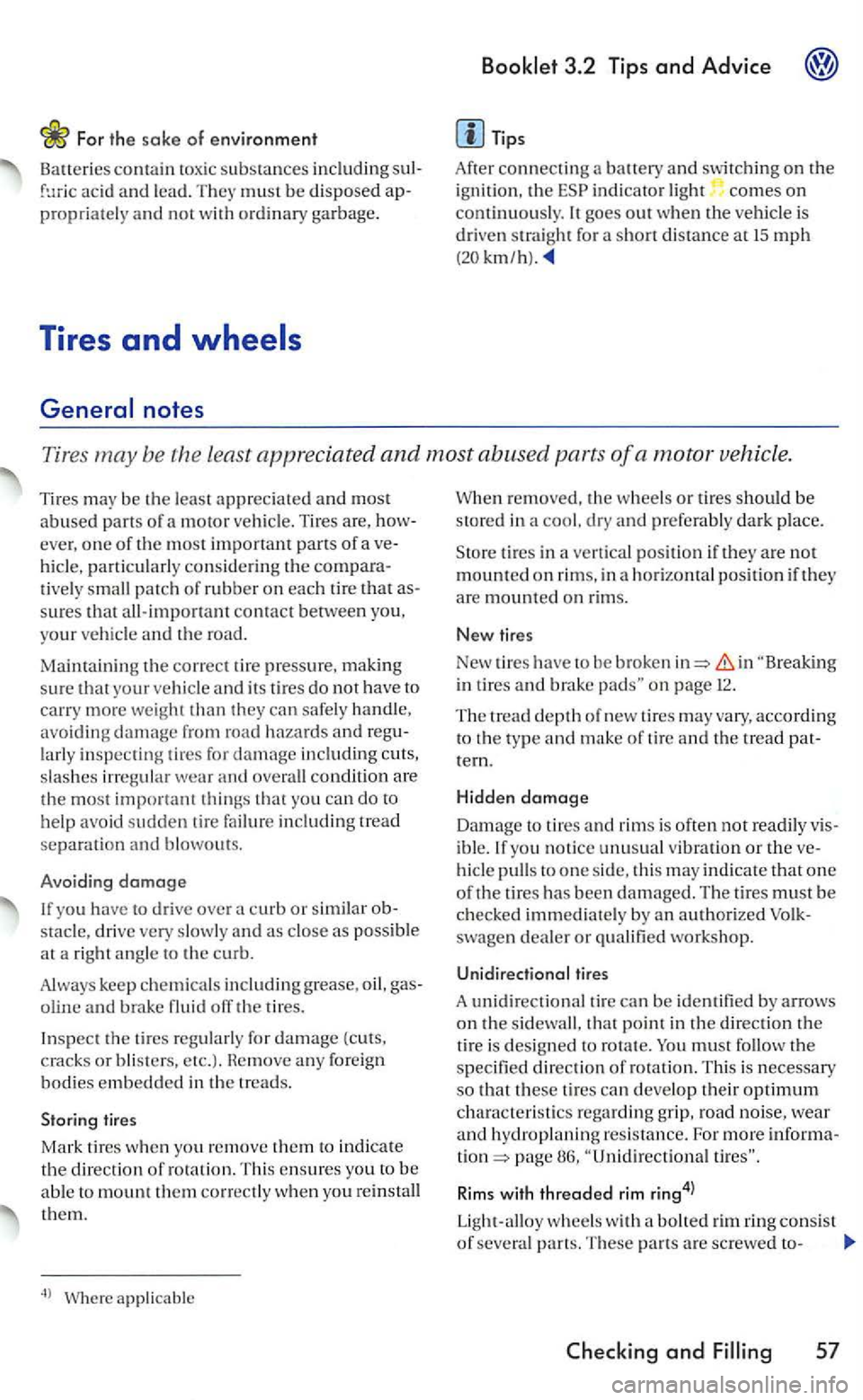
For th e sake of e nvironment
Baueries contain toxi c substances including aci d and lead. must b e disposed propriately and not with ordinary garbage.
Tires and
General notes
Tips
After connecti n g a battery and switching on the ig nit ion, the indicator light comes on continuously. It goes out when the ve hicl e is dri ven straigh t for a short distance at 15 mph km/h ).
Tire s may be the least appreciated and most abused parts of a motor vehicle.
Tires may be the lea st appreciated and most abuse d pa rts of a motor ve hicle. Tire s are, eve r, one of the mos t important parts of
safe ly handle,
avoi din g from road h aza rds and inspecting tires for damage including cuts,
sl ash es irregular wea r you can do to help avoid sudden tire fa ilur e including tread separation and blowouts.
Avo iding
damage
lfyou have to drive over stacle, drive very slowly and as close as poss ibl e
Wher e ap pli cabl e W
h
en removed, the wheels or t ires should be stored in cool. dry and p re ferably dark plac e.
tires in ve rtical position if they are not mounted on rims, in ho rizontal posi tion if they
in " 'B reaking in tire s and brake
type tern.
Hidd
en damoge
Da
mage t o tire s rims is often not readily
swage n dealer or qu alified workshop.
Unidir ection al tires
A unidirectio nal tire can b e idemified by arrows on the sidewall, that p oint in the direction the tire is designed to rota te.
p ag e "Unidirectional
Rims with threaded rim ring4l
Light-allo y wheels w ith a bolted rim ring consis t
o f several parts. T hese parts are screwe d to-
57
Page 346 of 444
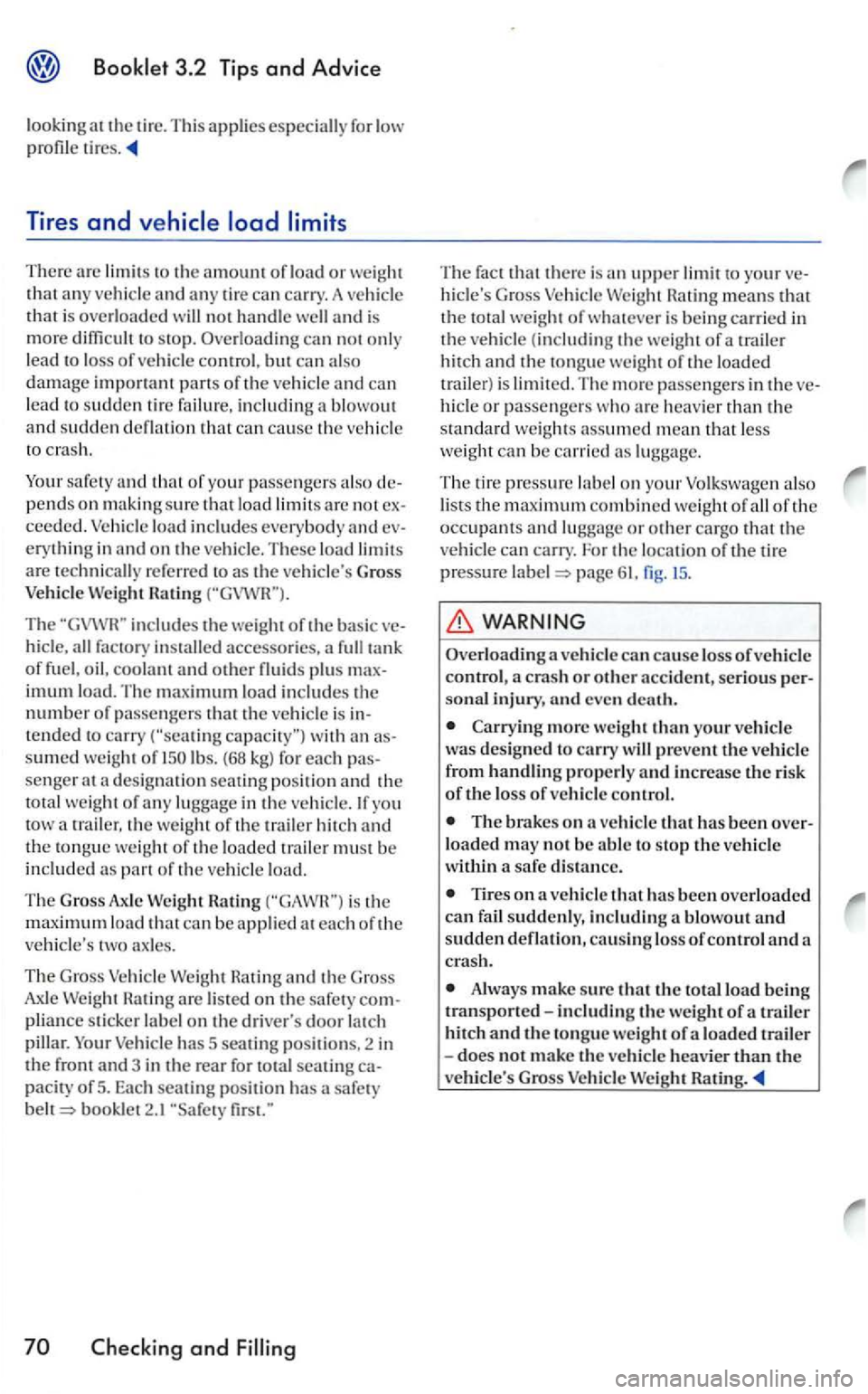
Tires and
There arc limits to th e amount of load or weig ht that any vehicl e and any tire can carry. A ve hicle that is overloaded will not handle well and is mor e to stop. Overloading can not only
lead l oss of ve hicle control. but ca n al so damage including a blowout
and s udden d eflatio n th at can cause the vehicl e
to crash .
Your safet y
and that of your passengers also de
pends on making sure th a t l oad limit s arc not exceeded. load in cludes everybody and everyth in g in and on the vehicle. These load limit s are technically refe rred to as th e vehicle' s Gr oss Ratin g
includes the weight of the basic veall factory installed accessorie s. a full tank of coolant and other fluids plus maximum load. The m ax imum load incl udes the number of passengers that the ve hicle is in tended to carry lbs. (68 kg) for each passenger at designation seating position and the
total wei ght of a ny lu ggage in the ve hicle. yo u the weig ht of the trailer hit ch and the tongue weight of the loaded trailer mus t be included o f the ve hicle load.
T he Gross
Axle is the m aximum load th at can be ap plied at each of the
veh icle's two
has 5 seat ing pos ition s, 2 in the front and 3 in the rear for seating capaciry of 5. Eac h seatin g posit ion ha s a sa fe ty bookle t2.1
and
The fact that there is an upper li mit to your ve
hi cle's Gross Hating means that the total weight of whatever i s bein g carried in the vehicle (in cluding the weight of a trailer hit ch and the tongue weig ht o f the load ed
t railer) is limited. The more passengers in the ve
hicl e or passengers are heav ier than the standard weig hts assumed mean that less weig ht can be carried lu ggage.
The tire pressure on your Volkswage n also lists the maximum combined weight of all of the occupants and
page fig . 15 .
WARNING
Overloading a ve hicl e can cause loss of vehicle control, a crash or other accident, serious pe r
sonal injury, nnd even dent h.
more weight than your vehicle was d esig ne d to carry will prevent th e ve hicl e
fr om handling properl y and increase the ri sk of th e loss of ve hicl e control.
The brakes on a ve hicl e that has been overloaded may not be abl e to sto p the ve hicle
w ithi n a safe di stance.
o n a ve hicle that has been overloaded can
Alway s make sure that the to tal load bein g transported-including the weight of a trail er hitch and the tongu e weight of a loaded trail er -does no t m ake th e ve hicle heavier t11e
ve hicl e's Gross Vehicle Rating .
Page 352 of 444
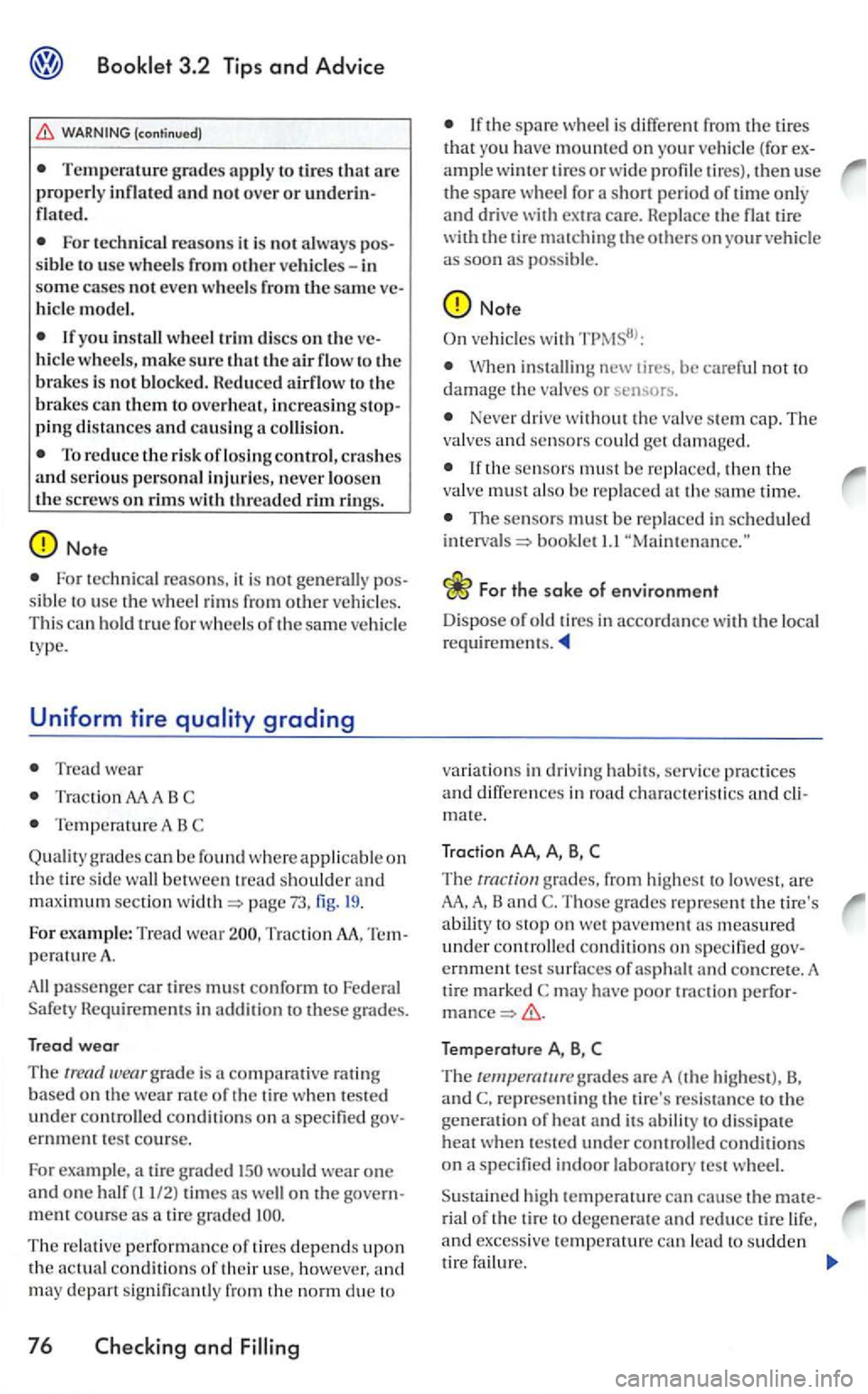
(continued)
For technical reasons it is not
I f you install wheel t rim discs on the ve
hicle wheels, make sure that the air flow to the brakes is not blocked. Reduced airflow to the brakes can them to overheat, increasing stopping distances and causing collision.
Note
For technical reasons. it is not ge nerally pos
s ibl e to use th e wheel rim s from other vehicle s.
This can ho ld true for wheels of the same vehicle
ty pe.
Uniform tire
Tr ead wear
Temperature A B
Quality can be found where applicable on the tire sid e wall between tread shoulder an d maximum section pa ge 73, fig.
For example: Tread wear Tra ction M, Te m
perature A.
All passe nger car tire s must conform to Federa l
Sa fe ty Hequirement s in addition to these grades.
Tread
wear
T he /read comparative rat ing base d on th e wea r rate of the tire when tested under controll ed co nditi ons on a sp ecifie d go v
ernment test course.
For exa
mple, a tir e graded would wear one and one half(ll/2) times as well on the govern
ment cou rse as a tir e
The relati ve performance of tires depends upon the actual conditions of th eir use , h oweve r, and m ay depart significantl y fro m the norm due to
76 Checking and
extra care. Replace the flat tire
with the tir e matchin g the others on your vehicl e
a s soon as poss ible.
Note
in stall ing new
drive without the va lve ste m cap. The valves and sensors co uld get damaged.
If the sen sors must be re pla ced, then the valve mus t also be replaced th e sa me time.
The sensors mus t be replaced in schedule d bookle t ...
For the sake of environment
Dispose of o ld tires in accordance w ith the local
requirement s.
variations in driving habits, serv ice pra ctices and diff ere n ces in road characteristics and cli
mate.
Traction
AA, A, B, C
T he
from highes t to lowest, are M, A, Band T hose grades rep resent the tire's abil iry to stop on wet pave ment measured under controlled conditions o n specified government tes t s urfa ces of and co ncre te. A
tir e marked may have poor tra ction perfo r
Temperatur e A, B, C
The lemperruuregrad es arc A (th e highest), B. and C, representing the tire's resistance the
ge neration of heat and its abilit y to diss ipat e heat tested under controlled conditi ons
o n a sp ecified indoor laboratory test wheel.
Susta ined hig h t em pera t
ure cause mate
rial of th e tir e to degenerat e and reduce tire lif e. and excessive tempera tur e